Bringing a brand new puppy home can be extremely exciting, and slightly overwhelming all at the same time! Puppies require a lot of care, attention, and training, which definitely takes time and patience on your part.
We’ve created this post on Yorkie puppy care, so that you can be totally prepared when you pick up your adorable pup, and spend lots of time snuggling and loving your new baby, rather than fretting about how to care for him properly!
We are going to cover a lot in this post, so hang in there! You may want to bookmark this page for future reference, or even print it out to have on hand.
Basic Needs and Additional Needs.
Every puppy has:
Basic needs – in order to keep him alive and healthy… and
Additional needs – in order to keep him happy and thriving.
Notice that both things are NEEDS, that every potential dog owner must be sure that they can provide before they decide to bring a puppy into the family.
Basic needs are:
- Food/Fresh Water (For a Yorkie – Proper feeding to help avoid Hypoglycemia)
- Sleep
- Safety
Additional needs are:
- Play/Exercise
- Vet Visits
- Grooming
- Training/socialization
- Lots of Love
Let’s break these down and talk about them separately so you know exactly what to do, and what to expect from your new best friend!
BASIC NEEDS
What to feed a Yorkie puppy.
You will want to keep your new puppy on the food that he or she has  been used to eating for at least a week or two. Let them get regulated into their new environment before you make a change in their diet. Yorkies are very sensitive to both stress, and changes in their food. Either of those things can easily cause major digestive upset. Once your friend has settled into his new home, then you can gradually make a change to a different food if you so desire. This process should be done slowly, start with mostly the old food, and just a bit of the new food. Do this for a few days, and then add a little more of the new food, and do that for a few days, until you have completely and successful switched over. This process should take about 7-10 days. If the puppy has a negative reaction to the new food, try reducing the amount and see if that helps. If not, then your puppy may not be able to tolerate the protein or grains in that food, and you may have to try a different food.
been used to eating for at least a week or two. Let them get regulated into their new environment before you make a change in their diet. Yorkies are very sensitive to both stress, and changes in their food. Either of those things can easily cause major digestive upset. Once your friend has settled into his new home, then you can gradually make a change to a different food if you so desire. This process should be done slowly, start with mostly the old food, and just a bit of the new food. Do this for a few days, and then add a little more of the new food, and do that for a few days, until you have completely and successful switched over. This process should take about 7-10 days. If the puppy has a negative reaction to the new food, try reducing the amount and see if that helps. If not, then your puppy may not be able to tolerate the protein or grains in that food, and you may have to try a different food.
It is important to start right out with a well-balanced, and nutritious dog food for your puppy, which is specifically designed for their growing needs. We have written an entire post that talks about our favorite dry dog food options for Yorkie puppies here!
– If you’re thinking – “ain’t nobody got time for that!” – then let us give you the fast version in the links below! 😉
Feeding Time and Avoiding Hypoglycemia.

Yorkie puppies (and all toy breeds) need a bit different scheduling and care when it comes to feeding time. This is because Yorkies, and smaller dogs in general, are more prone to becoming hypoglycemic. This is when a puppy’s blood sugar level drops dangerously low, and it can have devastating consequences for a puppy.
For this reason you will need to keep fresh food and water down for your Yorkie at all times until he is about 3 months old. Having food readily available will encourage a puppy to eat more often, and keep their blood sugar levels stable. A puppy sometimes needs to be reminded to eat, and where their food and water dish is located. Bring your puppy over to his or her dish often, and encourage them to eat. If they seem disinterested, try hand feeding them. My Yorkie ate so much better when it was out of my hand the first week. I am not entirely sure why, but for some reason it intrigued her.
Once a Yorkie has reached the age of 12 weeks, you can slowly transition them into 3 meals per day instead of having a constant food source.
It is very wise to have a tube of Nutri-Cal or Nutri-Stat on hand for your pup. Not only can this help prevent a hypoglycemic attack to begin with, but it can also save your puppy’s life in the instance where an attack is happening. (If you do not have either of these things during an emergency then use Karo syrup, honey, or regular pancake syrup.)

When I brought my little Willow home, I was instructed to give her a pea size amount of Nutri-Cal a few times per day. (once in the morning, and once before bed) to help protect her from hypoglycemia. She would just lick it off of my finger or a spoon, but if your dog doesn’t love the taste of it, you can gently rub it on their gums. I was also told to put a pea size amount of dark Kero syrup into her drinking water, which aids in keeping their sugar levels where they should be. I made a decision to wake up with her a couple times per night to make sure she got at least a bit of food in her system overnight for the first few weeks. I never had any issues while following these guidelines!
*Note* Keep in mind that I did not get my Yorkie until she was about 10 weeks old. This was a personal preference of the breeder. A lot of Yorkies will go home as early as 8 weeks old, so you may have to wake up through the night to feed your puppy, or take them to the potty, for a longer period, if he/she is 8 weeks old when you get them.
What to do if your Puppy becomes Hypoglycemic.
Here are some steps that you will need to quickly take if you think that your puppy is having a hypoglycemic attack:
1. Give your puppy some Nutri-Cal or Nutri-Stat. If your puppy will not take it from you directly, then he/she is already in a more advanced stage of hypoglycemia. In this case you will need to put some Nutri-Cal in a 3cc syringe and very carefully drip just a small drop into the puppies mouth. If he or she swallows it, then keep slowly dripping more until they have received about 1-1.5 cc of Nutri-Cal. If the puppy is not swallowing the first drop, then do not force anymore into their mouth. This means that they are in very advanced stages and action needs to be taken immediately. In this case you can rub some Nutri-Cal onto the gums, and very carefully insert a small quantity of Nutri-Cal, Kero Syrup, or honey into the dog’s rectum using a 3 cc syringe or eye dropper.
2. Keep your puppy warm. When a puppy’s blood sugar levels drop, they have a very hard time regulating their body temperature, and may become chilled. Wrap the puppy in a blanket or towel, and warm the blanket a bit with a hair dryer, or a heating pad.
3. Hydrate your Puppy. After a puppy suffers a hypoglycemic attack, they are usually dehydrated. If your puppy gets better, becomes more alert, and begins to walk around again, give him some pedialyte water to help balance out the minerals in his body. If you do not have pedialyte water, just offer tap or bottled water.
4. Contact or Go to your Vet. If your puppy is not showing improvement within 20-30 minutes you need to get that puppy to the vet as soon as you possibly can. If you live far from your vets office, I’d recommend just heading to the vet as soon as you have finished the first two steps above, just in case. Bring some water along with you for the ride in case your puppy begins to improve and becomes thirsty. If your puppy DOES improve quickly, you will still want to give the vet a call, tell them what happened, and what you did to treat it. It is important to determine why your puppy had an attack in the first place, to help prevent one from happening again.
Go to Sleep, Go to sleep, Go to sleep little Yorkie pup…..

How much do puppies sleep? – Yorkie puppies sleep A LOT. You can expect your new little friend to sleep anywhere from 15-20 hours per day. Over time, they will have more awake time, but in those first few months, take advantage of their awake time with plenty of play, exercise, and training! It would be a good idea to invest in a high quality, and super comfortable dog bed for your new best friend, to help him get the best sleep possible! Be sure to grab some puppy pads to put over top of their bed to protect it from accidents, especially overnight.
Here are some of our favorite orthopedic dog bed options.
What to do when they wake up – As soon as a puppy awakes from sleeping, you will need to take them to their designated potty area so they can relieve themselves. Due to their tiny size, which means a tiny bladder, Yorkshire Terrier puppies will need to go potty often. After sleep, after eating, and after play are all good times to try, but your pup may have to go even more often than this at first!

How to help them sleep well at night – It will take some time before your puppy fully adjusts to having more awake time during the day and sleeping through the whole night. Be patient, and work with your puppy to help them learn when it is time for play, and when it is time for sleep. Take your puppy for a walk, or have a really fun and energetic playtime a few hours before bed. This will tire your little friend out, and will, hopefully, help them sleep better! When you get up in the middle of the night to let your puppy go potty, or to give him a little snack, be very quiet, keep the lights dimmed, and do not encourage playtime with the puppy. He/She needs to learn, that even if they need to go potty, it is still sleep time, and they will be returning to their beds as soon as their “business” is finished.
*Tip* When I first got my Yorkie puppy, I kept her crate that she slept in up on my nightstand, so that she was near me. I could hear her when she cried, but she also needed to stay in her own bed. I did not allow her to sleep in my bed because I wanted to establish myself as the “Pack Leader.” Plus, with such a tiny puppy, it just isn’t safe for them to sleep in bed with you. If she was crying a lot for attention, I would just stick a few of my fingers in her crate and she would lick them, and then fall asleep next to them. It helped her feel safe and like I was close to her. Remember, puppies most likely slept with their brothers, sisters, and mother before their whole world abruptly changed, and now they don’t have any of their old pals. They will be confused, and a little scared. It is important to be very sensitive to this the first few weeks. Let them know you are there for them.
Keeping your Yorkie Puppy Safe. – It’s puppy proofing time!!
 Puppy-proofing your home is very similar to baby-proofing. Puppies (much like human babies) LOVE to explore. It is one of their most favorite activities! It is important to make sure that your home is a safe environment for them to be in. Let’s look at some specifics.
Puppy-proofing your home is very similar to baby-proofing. Puppies (much like human babies) LOVE to explore. It is one of their most favorite activities! It is important to make sure that your home is a safe environment for them to be in. Let’s look at some specifics.
1. Baby Gates – It may be useful to have a baby gate or two, to keep your puppy out of specific rooms, set boundaries, or to put up at the top of a staircase so that your puppy doesn’t fall down. Puppies can be clumsy, and aren’t always paying attention while they are playing or backing up. It can seriously injure a Yorkie pup if he accidentally falls down a staircase.
2. Toxins – Make sure that any poisonous liquids or medicines are kept up high, and double check the labels on cleaning chemicals, sprays you may use in your yard, etc. to make sure they are not dangerous to pets. Cigarette butts can also be extremely toxic to a puppy if swallowed, so be sure your puppy is not anywhere that he may find one. In addition to the obvious toxins, there are also certain foods and plants that are extremely toxic to dogs. Chocolate is a big one that most know about, but a lot of people don’t know that there is a whole list of foods that dogs shouldn’t eat. Like grapes for example, or onions! It is best for dogs not to eat table scraps anyways, but just be extra mindful of where you are leaving food, especially toxic foods, so that your pup cannot get into it. There are also several flowers and plants that are poisonous to dogs. That beautiful poinsettia you love to display around Christmas time? That is toxic if a dog ingests it. That wonderful blooming hydrangea bush you have in your garden? Toxic. I am not saying don’t have any of these plants in your home or garden, but if you do, you must be extremely mindful to not let your dog get into it.
Here is a great list of toxic foods from fidosfavorites.com
Here is a great list of toxic plants from thesprucepets.com

3. Small objects/dangerous objects – Puppies like to put everything in their mouths and chew on it. Be sure not to have small objects on the floor or within “reach,” and watch him while he is chewing a toy to make sure he isn’t ripping off tiny pieces that he could choke on. It is also wise to remove any power cords from the floor. Tie them up and tuck them behind tables or appliances.
4. Doggy Steps – Because Yorkies are so tiny, they can easily hurt themselves if they jump down off of couches, beds, or other high objects. It is highly recommended that you invest in a set of doggy stairs, like the ones I have linked below, to help them get up and down from high places. If you do not wish for them to join you on the couch or in bed, then it is important to implement training right away to teach them that it is not allowed.
5. Look Out! – It is easy for a puppy to get under your feet before you notice, which could lead to them getting stepped on, tripped over, or accidentally kicked. Make sure the whole family, and any visitors, know to look where they are stepping at all times, and to be conscious of where the dog is, so that he does not get harmed. Trauma from injuries is one of the leading causes of death for Yorkies, and it can be easily avoided if your whole household follows some safety guidelines.
– Read more on avoiding trauma injuries here –
Moving on to additional needs…
ADDITIONAL NEEDS
Playtime

All puppies need lots of playtime! There are SO many toys on the market today for dogs, but there are a few toy types that are very beneficial to have around for puppies.
The two kinds of toys that you will definitelywant to have on hand for your puppy are:
1. Chew toys! – Made especially for teething puppies. Puppies need to chew… a lot. They go through a teething process just like a human baby, and it hurts them too. Teething toys will make the process more comfortable for them. (and less difficult for you) Some of our favorite chew toys include: Nylabones that have different bumps and textures on the top which helps to soothe sore gums, Kong toys, (which usually double as entertainment toys) and tug ropes.

2. Activity toys – to provide entertainment, and mental stimulation for your pup if you are away, or if you just need to get something done around the house. Kongs, and Kong bones are awesome for this! Fill them up with peanut butter and some dog food, and it can provide an hour of fun and “work” for your pup. The balls that dispense food or treats as they are rolled around is also a favorite in our household.
I have linked some of Willow’s favorites below. 😉
There is actually a neat training technique where you feed your dog by only using toys that require them to “work” to get it out. This provides them amazing stimulation, teaches them that they must work for their food, (another good way to establish yourself as the pack leader) and it also releases some stored up energy! However, because Yorkie puppies are prone to developing hypoglycemia, this training tactic would not be good to fully implement on a Yorkie puppy. Instead, have food down for your pup at all times, but make them work like this for their treats. After the four-month mark when hypoglycemia is less likely, you could start implementing this technique for meals as well, just make sure that your pup actually gets all of her meal and isn’t just “giving up” and not eating. In other words, don’t use a toy that is too difficult for them to get the food out if you are using it to feed meals.
*Note* Be very careful of cheap stuffed toys, or thin rubbery toys, that are easily destroyed by your puppy. These toys can be a chocking hazard, or a blockage issue within the body, if small pieces are able to be torn off and swallowed.
Exercise
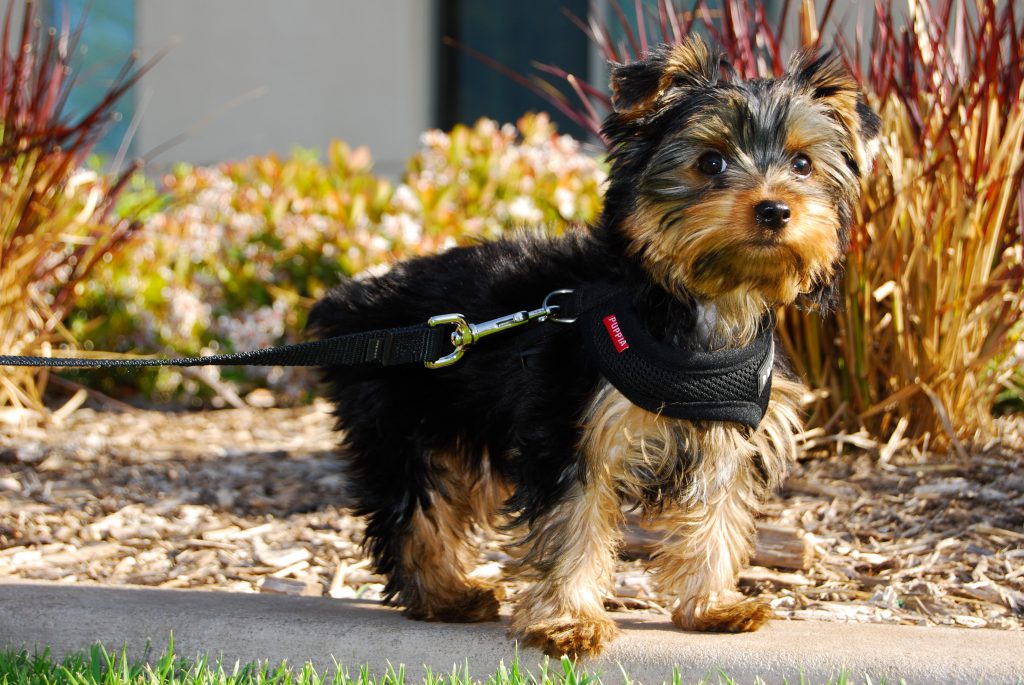
Just because Yorkies are small does not mean that they don’t need to exercise. They do require less exercise than some larger more energetic breeds, mostly because Yorkies can get out a lot of energy from just running around the house or backyard, but they still enjoy, and should be given a daily walk! Two 15-20 minute walks per day is great, but a Yorkie can do fine with just one walk per day as well, if that is all that your schedule allows for. Walking is a wonderful way to keep your dog healthy, grow strong muscles, help socialize your puppy, aids in keeping their heart healthy, and can even build their immunity, and help them sleep better at night! (which can be a life saver if you have a puppy that tends to need extra attention during the night-time hours.
Walking is a wonderful way to show your dog that you are the pack leader. Implementing and mastering the heel command from an early age is hugely beneficial to your relationship with your pup. They will be better behaved, mentally and emotionally healthy, and they will become an all around more enjoyable dog if you establish yourself as the leader in the correct way from the very beginning.
– Walking a dog who has been taught how to heel also makes daily walks much more pleasant for the human involved as well! 😉
*Important Note #1 – Now, there is a window of time between the puppy not receiving antibodies from his mother’s milk anymore, and before his vaccinations have had time to truly kick into gear, when he or she will be more vulnerable to infectious diseases. For this reason it is important to not take your puppy on public outings where they may come in contact with another dog, or be where another dog has been, until they have received all of their puppy shots. Usually by the time a puppy is about 4-5 months old, they will be done with their initial shots, and it will then be safe to take him on public excursions. Until then, it is best to keep the exercise in and around your home. If you want to take your pup on a public outing before he is done receiving his puppy shots, consider bringing him along in a carrying bag, or in a doggy stroller!
To read more about our top doggy stroller picks for small dogs, click here!
Again, if you are short on time, but still want to know our favorites, I’ve inserted links below. 🙂
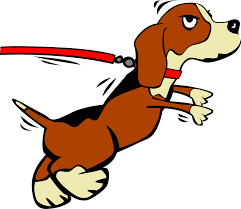
*Important Note #2 – Yorkies (and most toy breeds) are much more susceptible to a condition called collapsed trachea. For this reason, it is imperative that you use a harness with your Yorkie instead of a traditional collar when walking them. Traditional collars put too much pressure on the dogs throat, which then pushes against their trachea, and can cause it to collapse, or make an already weakened trachea worse. A harness puts pressure against the dogs chest rather than their throat, and protects them from unnecessary harm, or further harm, to their delicate trachea. It is also much easier to control a lunging, or pulling dog on a harness rather than a collar.
Like the fast track better still? The links to our favorites are below!
Vet visits
Most reputable breeders will actually require you to bring your pup in for a vet visit within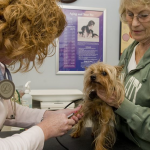 a certain amount of time after taking him home, in order for their health guarantee contract to stand. A responsible breeder will also have your puppy up to date on all of his/her shots that are needed by his/her particular age. You will be responsible to take your puppy to the vet to receive the remainder of their puppy shots, and will need one or two check ups per year after that.
a certain amount of time after taking him home, in order for their health guarantee contract to stand. A responsible breeder will also have your puppy up to date on all of his/her shots that are needed by his/her particular age. You will be responsible to take your puppy to the vet to receive the remainder of their puppy shots, and will need one or two check ups per year after that.
It is vitally important to be diligent in bringing your pup in for their check-ups and keep them up to date on their vaccinations. Vets are trained to notice things that we may not see. They could potentially spot something that we completely overlooked during a yearly check-up, and vaccinations can protect from many deadly diseases.
There are some common health issues that the Yorkshire Terrier breed can be born with or acquire, so it is also very important to know what these health issues are, and to learn the symptoms, so that you can bring your dog to the vet at the first sign of an illness. Many of the problems that are more common for Yorkies, do not have to be fatal, and can be treated if caught early. Be observant, and watch for odd or different behaviors, or appearances in your pup. If you notice something off, do not hesitate to get him or her checked out by your vet.
Grooming Needs

Yorkies are definitely a dog that needs to be groomed. If you keep their hair short they will need to visit the groomer once every 4-8 weeks, depending on the cut, to keep it shaped up. (If you are interested in learning how to cut your pups hair by yourself in an easy to maintain style, check out this post we created with video tutorial included.) If you are planning on keeping your Yorkie’s hair long, then daily brushing, and more frequent bathing will be required.
Here is a list of grooming requirements that your pup will need, and how often they should be done.
Bathing – In general a Yorkie will need to be bathed once every 3-4 weeks. Yorkies kept in a long coat may need a bath once every 2-3 weeks.
*Post and video tutorial on how to bathe your Yorkie here*
Brushing – Daily brushing will be needed for a Yorkie kept in a long coat, and brushing once every 3-5 days will be needed on a Yorkie kept in a shorter coat, depending on how short it is. Some dogs may even need brushing a few times per day if their hair is very fine and prone to tangling easier.
Nail Trimming – This will need to be done every 2-8 weeks, depending on your dog and how fast their nails grow. If you are nervous about doing this on your own, your vet or groomer would be happy to do it for you.
*Post and video tutorial on how to cut your Yorkie’s nails here*
Ear Cleaning – Every time you give your Yorkie a bath, you will want to gently wipe out their ears with a damp washcloth to clean any debris. Every other month or so, a more thorough cleaning with an ear cleaning solution is a good idea. It is also important to remove hairs that are growing within the canal, so that dirt and debris can’t stick to it and cause infection. Again, if you are more comfortable with a vet or groomer doing this for you, by all means, let them do it!
Teeth Brushing – You may think it is silly to brush a dog’s teeth, but it is extremely important. One of the health problems that Yorkies are more prone to is dental disease. Their tiny mouths can easily become overcrowded which is the perfect environment for plaque to hide and build up. If infection sets in, it can spread to other parts of the body. Brushing your pup’s teeth once per day could save him from losing his teeth in the future, and can even help lengthen his life.
*Note* Be sure to check the ears regularly for signs of infection, such as: redness, irritation, discharge, or a foul odor. These can all be symptoms of an ear infection which will warrant a trip to the vet.
Here are a few of our favorite grooming supplies for Yorkies.
Training your new puppy.
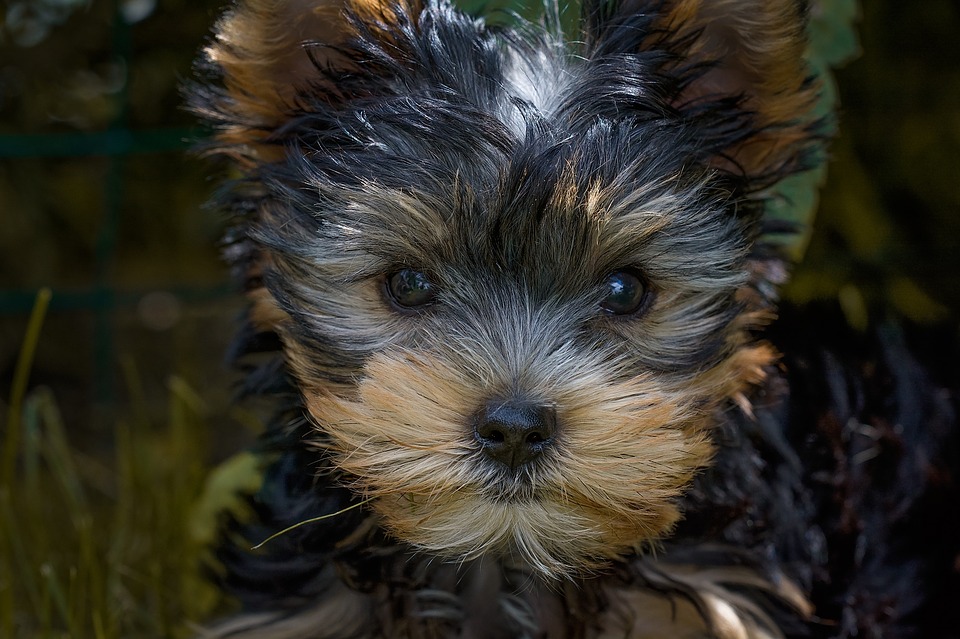
Your new little pal is going to need plenty of training and socialization.
Training can look like many things. It can look like potty training, teaching your dog boundaries, teaching them commands, or teaching them tricks. All of these are great mental exercises to help give you a well-behaved dog, with a calm and submissive energy. Puppies will need a lot of time spent on training exercises, but be sure to not “over-work” them to the point where you and your puppy become frustrated. Balance work time with play time to keep it a positive experience for your pup. It is best to only work on training for a few minutes at a time, but multiple times per day. As your pup gets older and better within his training, you can increase the amount of time that you spend during each training session, and decrease the number of sessions per day.
Potty Training.
This of course does not apply to potty training, as this needs to be very consistent, and a constant learning experience for your puppy. As mentioned above, your puppy should be taken to her potty spot every time she wakes up from sleeping, finishes eating, and after playtime. Yorkies have very small bladders and may need to be taken out several times between these activities as well. This breed is a bit harder to potty train, so just be patient and kind, and keep giving them positive reinforcement when they go potty in the correct place!
No matter which potty training method you end up going with, there will be accidents. Do not punish your puppy, or rub their nose in their own waste when they have an accident. That is not only unsanitary and quite frankly, unkind, but it most likely will not work either. It does not teach the puppy that they went in the wrong place. It teaches them that when you SEE them do their business inside they will get in trouble. Most likely, they will just make sure you don’t see it next time. Meaning, they’ll hide somewhere in the house and make a mess… Sneaky little buggers I know.
When your pup makes a mistake, be kind. You can give them a firm No, but do not yell. Just say no, bring them outside as soon as it happens, and say your potty command. Like “Go potty” or “Do your thing.” If you did not see your puppy have the accident, then don’t say anything to the pup. If you say “No” at this point, they will not associate it with the accident, they will associate it with whatever they were currently doing. Quietly clean it up, and try to get them out to their potty spot more often. Accidents are inevitable. So buy yourself a big ol’ jug of Nature’s Miracle, and have patience with your new friend.
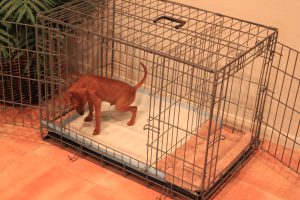
If you are looking for an easier way to potty train your Yorkie (or other small dog) You should definitely check out the Potty Training Puppy Apartment by Modern puppies. I used this for my Yorkie, and it was a life saver for us.
I wrote an entire post about it here. Check it out and see for yourself! There may even be a coupon code included in that post to get 5% off your entire purchase if you decide to try the potty training puppy apartment! 😉
TEACHING COMMANDS – Teaching basic commands is SO important. It not only gives you a very obedient, and well-mannered dog, but it can also be beneficial in a dangerous situation. If your dog happens to get outside without a leash, and is running towards the road, a firm command such as: SIT or STAY or COME, may just save your dogs life if they have been trained these commands properly. There are so many YouTube videos out there showing you step by step how to train your dog to follow commands. Look some up, and be prepared with the training method you want to use for your puppy before you bring her home.
TEACHING TRICKS – Teaching tricks is really fun, and is a great way for you and your dog to work together and bond. Yorkies tend to learn tricks incredibly fast. They are highly intelligent, and are VERY food motivated. So it is rather simple to get them to spin, or roll over.
TEACHING BOUNDARIES – Dogs need boundaries. If you give them full run of the house and let them do whatever they’d like, I can promise you that they will develop negative behavioral issues. They will become the Alpha dog, which means they believe they are the leader of the household. This can cause aggression towards strangers and even family members, separation anxiety, soiling/marking in the house, out of control jumping up and barking, and more. Set boundaries for your dog from the very beginning and stick to them!
Socializing your puppy.

Socializing is such an important step in bringing up a well-rounded and happy dog. They need to get out in the world and experience all the different sounds, sights, touches, and smells.
Oh, the places you can go! – After your puppy has received all of their puppy shots, take them with you everywhere that you can. Dog parks, stores that allow dogs, outdoor restaurants that allow dogs, beaches, walks in busier areas, and events in your downtown neighborhood or city can all be great places to expose your dog to all different people, places, and experiences. If he gets used to children, other dogs and animals, all kinds of vehicles, loud noises, and weird smells while he is young, then he will be less likely to develop a fear or aggression towards any of those things as he ages.

Take your time, and let puppy adjust. – Make sure you do this slowly, don’t pack in a bunch of new creatures, sights, and sounds all in one day. Start small with just a few people coming over to visit, then take your pup for walks where you will encounter other dogs and people. If they do well with those things move on to a dog park, or a public store that they can come along to.
It is important not to overwhelm them, but as they gain comfort in new situations, slowly graduate them to busier, environments and experiences.
A well socialized dog is a happy dog. Plain and simple!
Prepare your pup for future situations. – While you are spending snuggle time with your puppy, get him used to touch on different parts of his body. Touch his legs and rub his little feet so that he allows a groomer to do that as well. Touch his lips and feel his teeth so that he will let a veterinarian examine his mouth. Rub his ears, lay him on his back, and rub his tummy so he is comfortable being handled in these ways in case a veterinarian or groomer needs to do the same. This can make for much easier and less stressful vet and groomer visits in the future.
Last but definitely not least, your puppy will need lots of love.

Puppies are wonderful little souls. Overflowing with personality, and ready to give us their entire hearts full of unconditional love. They are so pure and special. It is our job, and responsibility, to give them everything that they need and more, but what they want from us the most, is our unconditional love in return.
I leave you with this quote…
“He is your friend, your partner, your defender, your dog. You are his life, his love, his leader. He will be yours, faithful and true, to the last beat of his heart. You owe it to him to be worthy of such devotion.” – Author Unknown.
If you have any questions at all, or can’t find what you are  looking for, feel free to ask in the comments section below! Willow and I will bark back to you as soon as we can. 😉
looking for, feel free to ask in the comments section below! Willow and I will bark back to you as soon as we can. 😉

– Save this information for later, and help us spread the word by pinning this post to Pinterest!
Hover over the photo to see the Pin it option.

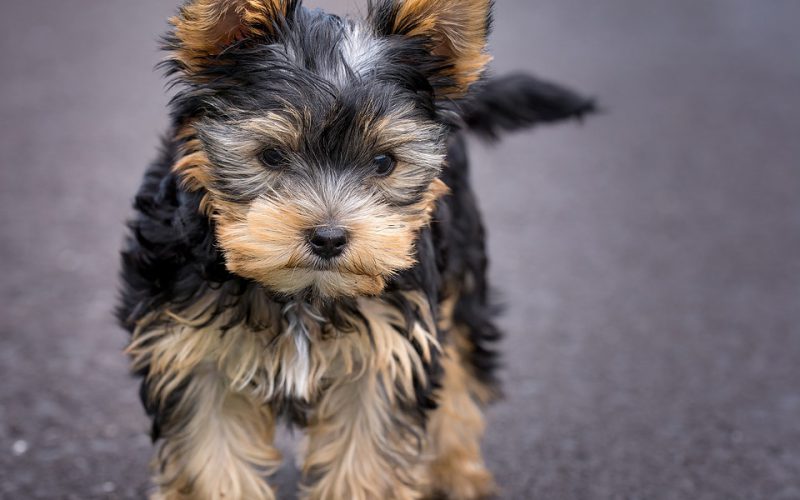

Hey,
I must say, you and your Yorkie are absolutely adorable, and you must have had your hands full with that little booger!!
Willow is in great hands, and I wouldn’t mind even a pinch of that love and care, haha!!
🙂
Anyways, you were right, I did not know dogs shouldn’t eat grapes or onions.
There’s a lot you got here that, well, it’s stuff that you sort of know, but you don’t think about sometimes, and it’s cool that you point this out to Yorkie owners.
Anyone with an Yorkie should give this a read.
Thank you for the information. I will be glad to refer back to this if/when needed.
Thank you so much! It is easy to think that dog’s can eat everything, but just because they WILL eat anything, doesn’t mean they SHOULD! haha… Thanks so much for stopping by! 🙂
Wow. Great post! Very informative and detailed. I have never owned a yorkie myself but have always found them so adorable. This post intrigued me so much, to the point i may have to go find me my own yorkie pup. After reading this I am confident I have the knowledge to own one and take care of it properly. I would have had no clue about hypoglycemia issues. Thank you. And I loved your use of visuals throughout your post and your own personal photo of you and your pup. Great read
Thank you so much Jeremy! You should definitely consider getting one of your own. 😉 They are the best! I am so glad you were able to learn something new. A lot of people don’t know about hypoglycemia in dogs, but it is very real, and can happen easily to a Yorkie pup. ( Or any toy breed )
Thank you for stopping by!
Wow, what an in depth post on Yorkie Puppy Care. I enjoyed reading it and have gained so much new knowledge from your post. Keep up the good work! I plan on checking out your other posts as well!
Thank you Clyde! I am passionate about the breed for sure. They’re just the best! Glad you were able to learn something new. 🙂
Thanks for stopping by!
My in-laws had a “teacup” Yorkie – I think he weighed a total of 2.5lbs. I’m glad you mentioned the part to keep them warm, as Yorkie’s don’t have ‘fur’ like most other dogs, they have ‘hair’. Because of this and not having a 2nd undercoat, they can chill easily.
This is absolutely right! Thanks for visiting Dave!
it is amazing to me how much care is needed for something so tiny. But it is well worth it in the end. Dogs are the most loyal creatures in the world. Coming to a new home can be just as exciting and overwhelming to them as it is to you. So making sure you have everything ready to go not only helps you but it helps out your new fur baby as well.
Absolutely!! It makes it a much smoother transition for everyone 🙂
Are Yorkie diggers ,when will they lose there baby teeth
None of my Yorkies were/are diggers, but that’s not to say that they all aren’t! Typically though, I don’t think that is a common personality trait of a Yorkie. Yorkies lose their baby teeth between 4 and 8 months old!
I have an 11 week old yorkie that I got a week ago and it is very picky. I have had 1 sugar drop so far and it was terrifying. He was taken to the vet and she praised me on using honey during this time. They did find a blockage and I believe it was due to me feeding him chicken because he would not eat and I had a fear of his sugar dropping. It was very scary and I have been very careful in what I give him. The vet gave him metronidozal for his tummy and said to give him chicken and rice for a few days. I noticed he will eat alot one day and not the next. I also get scared when he is resting for hours. His bowels I believe are getting to be normal as he went more than once yesterday which was a first. He did have mucas looking stuff in his last stool. That scared me again. He is drinking on his own playing but resting for long periods of time. He has a follow up visit next week and is scheduled for his rabies and 3rd round of parvo. I would love and appreciate your input! At this point my girlfriend is so scared to be left alone with him and I’m up all night checking on him.
I would highly recommend THIS gel for your puppy! You can put it in their food to try and encourage them to eat (it tastes good) or just take a dap and put it in their mouth here and there. It is a high calorie nutritional additive, so they get the calories and sugar they need even if they are being picky and refusing to eat. This is a common problem for Yorkies and it is why I recommend that everyone have some of this stuff on hand!!! It is great peace of mind. ❤️